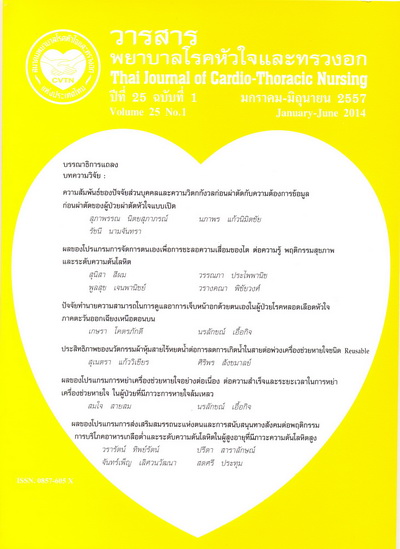ผลของโปรแกรมการจัดการตนเองเพื่อการชะลอความเสื่อมของไตต่อความรู้ พฤติกรรมสุขภาพและระดับความดันโลหิต
Keywords:
การจัดการตนเอง, ผู้ป่วยโรคไตเรื้อรัง, พฤติกรรมสุขภาพ, ระดับความดันโลหิต, Self – Management Program, Patients with Chronic Kidney Disease, Health Behavior Blood Pressure LevelsAbstract
การวิจัยแบบกึ่งทดลองนี้มีวัตถุประสงค์เพื่อศึกษาผลของโปรแกรมการจัดการตนเองเพื่อการชะลอความเสื่อมของไต ต่อความรู้ พฤติกรรมสุขภาพ และระดับความดันโลหิต โดยศึกษาแบบกลุ่มเดียววัดก่อนและหลัง เลือกกลุ่มตัวอย่างแบบเฉพาะเจาะจงเป็นผู้ป่วยโรคไตเรื้อรังระยะที่ 1 – 3 ที่มารับบริการที่แผนกผู้ป่วยนอกอายุรกรรม และคลินิกเฉพาะโรคอายุรกรรมโรคไต โรงพยาบาลราชวิถี จำนวน 20 ราย เข้าร่วมโปรแกรมการจัดการตนเองในผู้ป่วยโรคไตเรื้อรัง ประกอบด้วยการให้ความรู้และฝึกทักษะการจัดการตนเองรายบุคคลโดยใช้สื่อการสอนและมอบคู่มือการปฏิบัติตัวในผู้ป่วยโรคไตเรื้อรัง สมุดบันทึกพฤติกรรมสุขภาพให้ผู้ป่วยนำกลับไปใช้ที่บ้าน ติดตามความก้าวหน้าโดยการโทรศัพท์สัปดาห์ละ 1 ครั้ง เป็นเวลา 2 สัปดาห์ และส่งข้อความสั้นทางโทรศัพท์เคลื่อนที่สัปดาห์ละ 1 ครั้ง เป็นเวลา 4 สัปดาห์ เก็บรวบรวมข้อมูลก่อนและหลังการเข้าร่วมโปรแกรม โดยใช้แบบประเมินความรู้เกี่ยวกับโรคไตเรื้อรัง แบบประเมินพฤติกรรมสุขภาพ และติดตามระดับความดันโลหิต
ผลการศึกษาพบว่า กลุ่มตัวอย่างมีค่าเฉลี่ยคะแนนความรู้เกี่ยวกับโรคไตเรื้อรังและค่าเฉลี่ยคะแนนพฤติกรรมสุขภาพเพิ่มขึ้นหลังได้รับโปรแกรมการจัดการตนเองอย่างมีนัยสำคัญทางสถิติ (p < .05) อย่างไรก็ตาม ค่าเฉลี่ยความดันโลหิตในกลุ่มตัวอย่างก่อนและหลังได้รับโปรแกรมการจัดการตนเองไม่แตกต่างกันอย่างมีนัยสำคัญทางสถิติ
ผลการวิจัยเสนอแนะให้มีการนำโปรแกรมการจัดการตนเองไปใช้ในสถานบริการสุขภาพอย่างต่อเนื่องเพื่อส่งเสริมให้ผู้ป่วยโรคไตเรื้อรังมีพฤติกรรมสุขภาพที่เหมาะสมและสามารถควบคุมระดับความดันโลหิตเพื่อช่วยชะลอความเสื่อมของไต
The Effect of Self – Management Program for slow Chronic Kidney Disease Progression on Knowledge,Health Behavior and Blood Pressure Levels
The present study aimed at investigating the effects of a self-management program for slow chronic kidney disease progression on patient’s knowledge, health behavior, and blood pressure levels. A one-group pretest-posttest design was used in this study. The sample was recruited by means of purposive sampling based on the following inclusion criteria: they had been diagnosed with chronic kidney disease stages 1-3, and had sought services at the outpatient medical ward and the renal clinic at Rajavithi Hospital. The total number of subjects was 20. The self-management program of patients with chronic kidney disease consisted of giving information and practice of chronic kidney disease management individually by using audio visual, providing a manual on self-care practice of chronic kidney disease, and recording their own health behavior when they were home. The researcher followed up the patients by using telephone calls to patients once a week for two weeks and sending short messages to them once a week for four weeks. Data were collected before and after implementating the self-management program using the questionnaires of knowledge and behavior of chronic kidney disease and the health behavior record including monitoring blood pressure levels.
The study findings revealed that the subjects’ mean score on overall knowledge of chronic kidney disease and mean score on overall health behavior were higher after receiving the self-management program with statistical significance at p < .05. However, the means of blood pressure levels before and after receiving the self-management program were not significantly deferent.
Thus, it is recommended that dissemination the self-management program to apply in health service continuously to promote healthy behaviors in patients with chronic kidney disease including control the blood pressure levels in order to slow chronic kidney disease progression.
Downloads
Published
How to Cite
Issue
Section
License
บทความนี้ยังไม่เคยตีพิมพ์หรืออยู่ในระหว่างส่งไปตีพิมพ์ในวารสารอื่น ๆ มาก่อน และกองบรรณาธิการขอสงวนสิทธิ์ในการตรวจทาน และแก้ไขต้นฉบับตามเกณฑ์ของวารสาร ในกรณีที่เรื่องของท่านได้ได้รับการตีพิมพ์ในวารสารฉบับนี้ถือว่าเป็น ลิขสิทธิ์ของวารสารพยาบาลโรคหัวใจและทรวงอก






